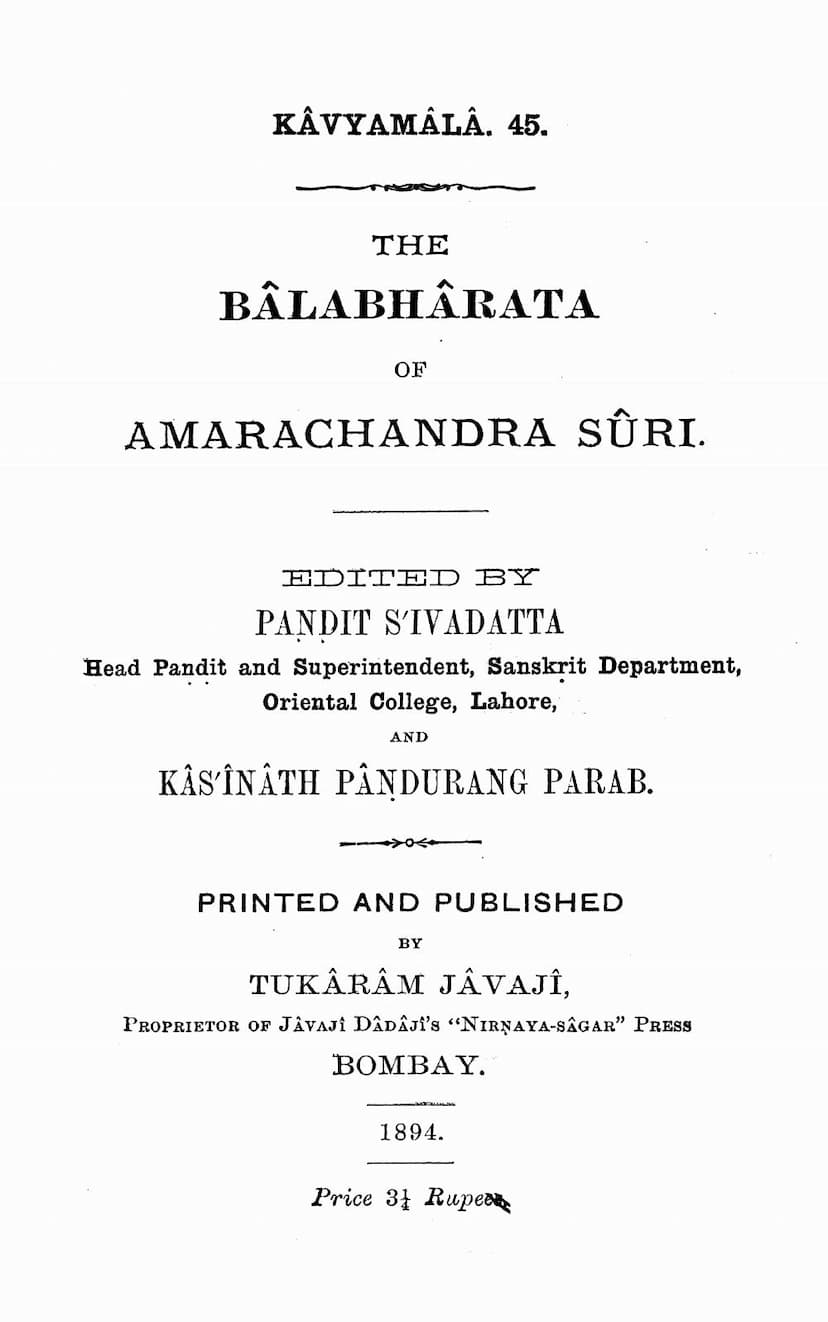Balabharata
Added to library: September 1, 2025

Summary
This is a comprehensive summary of the "Balabharata" by Amarachandra Suri, based on the provided text and catalog link:
Title: Balabharata Author: Amarachandra Suri Editors: Pandit Shivadatta, Kashinath Pandurang Parab Publisher: Tukaram Javaji, Proprietor of Javaji Dadaji's "Nirnaya-Sagar" Press, Bombay Year of Publication: 1894
Overview:
The Balabharata is a poetic rendering of the Mahabharata epic, composed in Sanskrit by the Jain scholar Amarachandra Suri. This particular edition, published by Tukaram Javaji, was meticulously edited by Pandit Shivadatta and Kashinath Pandurang Parab. The text itself is a rich source of information about the author, Amarachandra Suri, and his prominent role in Jain literary and religious circles, particularly during the period of King Visaladeva.
Author and Historical Context:
The "Bhumika" (Preface) provides significant biographical details about Amarachandra Suri. He was a disciple of Shri Jinadatta Suri, a renowned figure within the Jain tradition. Amarachandra Suri received his knowledge of grammar and poetry from Kaviraja Amarasingha. The text places Amarachandra Suri's activity during the reign of King Visaladeva, the ruler of Gujarat, in the 13th century CE (Vikram Samvat 1243-1262). His poetic prowess was highly regarded, earning him the title "Veni-kripan" (a metaphor for sharp and effective speech), comparable to other renowned poets like Deepika and Kalidasa. He received patronage and praise from rulers of Maharashtra and other regions.
Content and Structure:
The Balabharata covers the narrative of the Mahabharata, though this edition focuses on the early parts, specifically the Adi Parva, and proceeds through subsequent Parvas such as Sabha Parva, Vana Parva, Virata Parva, Udyoga Parva, Drona Parva, Karna Parva, Shalya Parva, and Sauptika Parva, ending with a description of the founding of Hastinapur and the Pandavas' return from exile.
- Adi Parva: The initial chapters describe the lineage of the Pandavas and Kauravas, the birth of Panduputras, and the tragic circumstances surrounding their childhood. It details the events leading to the Pandavas' exile.
- Sabha Parva: This section likely covers the establishment of the Pandavas' kingdom, the construction of Indraprastha, and significant court events, including the game of dice.
- Vana Parva: The forest exile of the Pandavas is depicted, including their interactions with sages, celestial beings, and various challenges they faced in the wilderness.
- Virata Parva: The Pandavas' incognito stay in the kingdom of King Virata is narrated.
- Udyoga Parva: This part of the text focuses on the efforts at peace negotiations and the events leading up to the Kurukshetra war.
- Drona Parva: The narrative shifts to the military prowess and strategic aspects of the war, focusing on the role of Dronacharya.
- Karna Parva: The prowess and tragic destiny of Karna are likely highlighted.
- Shalya Parva: This section would detail the events involving Shalya and the continuing conflict.
- Sauptika Parva: The night raid and the aftermath of the battle are described.
- Shanti Parva: This Parva discusses dharma, rajadharma (duties of a king), and philosophical discourses.
- Ashrama-vasa Parva: The text portrays the Pandavas' life in exile and their eventual return from the forest.
- Maushala Parva: This section covers the events following the Kurukshetra war, including the destruction of the Yadavas and the departure of Krishna.
- Mahaprasthana Parva: The great journey of the Pandavas towards their final liberation is described.
- Swargarohana Parva: The text concludes with the Pandavas' ascension to heaven.
Editorial Notes and Significance:
The editors, Pandit Shivadatta and Kashinath Pandurang Parab, acknowledge the use of multiple manuscripts (K, Kha, Ga) in their editorial process. They mention that some verses from the "Pandit" journal are included, as well as references to other works like the "Hammira Mahakavya." The preface also discusses the challenges of textual reconstruction and the scholarly contributions of figures like Professor Abaji Vishnu Kathavate and Dr. Ramkrishna Gopal Bhandarkar, indicating a robust academic engagement with the text. The detailed footnotes and cross-references within the text highlight its importance for scholarly research.
Key Themes and Highlights:
- Poetic Excellence: The Balabharata is praised for its rich Sanskrit, elaborate descriptions, and skillful handling of poetic meters and figures of speech. The "Kavi-prasasti" section, in particular, is a testament to Amarachandra Suri's poetic talent, featuring numerous complex "samasya" (enigmatic verses) composed by other poets and completed by him.
- Jain Influence: While the Balabharata retells the Hindu epic, its author's Jain identity might subtly influence its interpretation or focus, though the provided text doesn't explicitly detail specific Jain doctrines within the narrative itself. However, the extensive genealogical and historical details within the preface suggest a deep integration into the broader intellectual landscape of the time, where Jainism was a significant force.
- Historical Documentation: The extensive genealogies of the Chalukya dynasty rulers, particularly mentioned in relation to the poet Someshvara Deva, provide valuable historical data. The editors' meticulous footnotes often cite these connections and historical periods, enriching the text's historical value.
- Literary Merit: The Balabharata is presented as a significant contribution to Sanskrit literature, admired for its narrative flow, character portrayals, and sophisticated language. The editors aimed to make this valuable work accessible through their edition.
Overall Significance:
This edition of the Balabharata by Amarachandra Suri is a scholarly endeavor that brings to light a significant work of Sanskrit literature by a prominent Jain poet. It serves as both a literary monument and a historical document, offering insights into the cultural and intellectual milieu of medieval India and the contributions of Jain scholars to classical Indian literature. The detailed biographical information and editorial notes make it a valuable resource for researchers in Sanskrit literature, Jain studies, and Indian history.